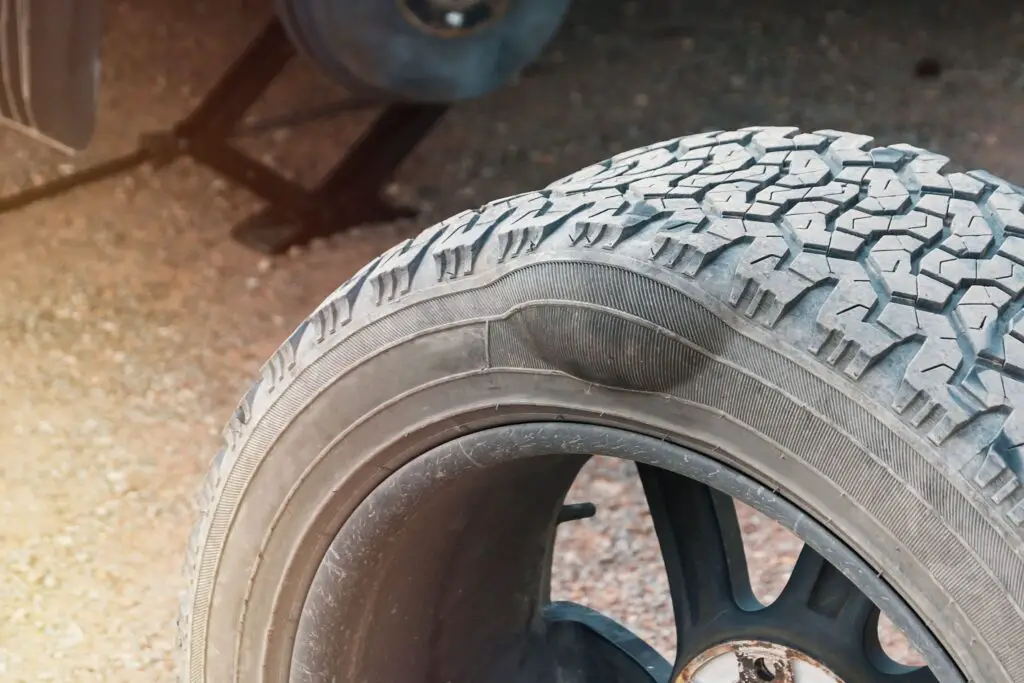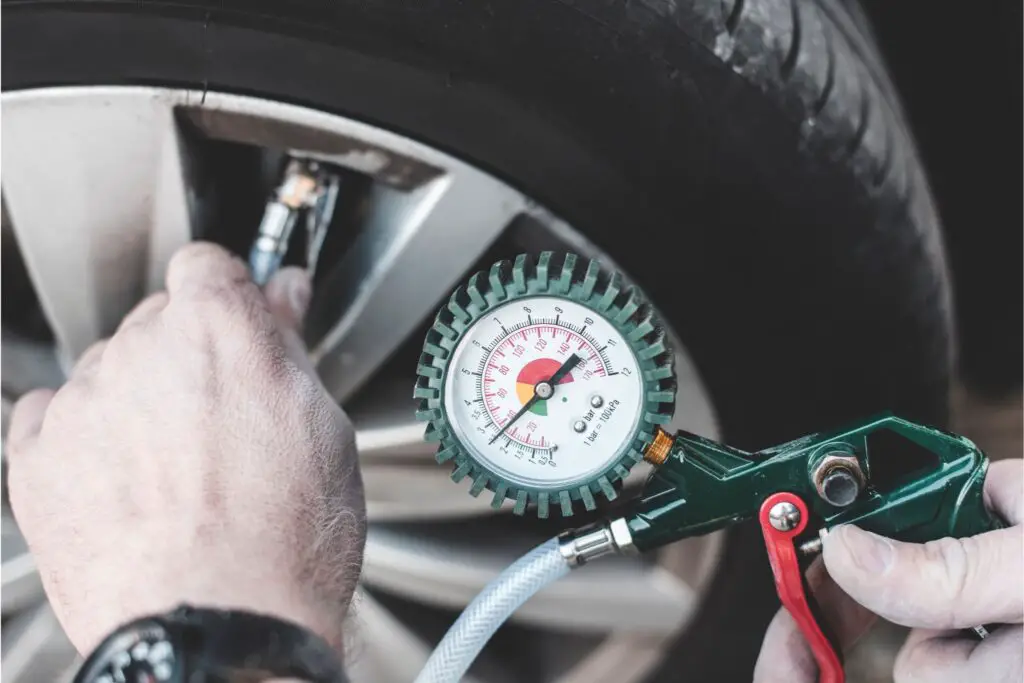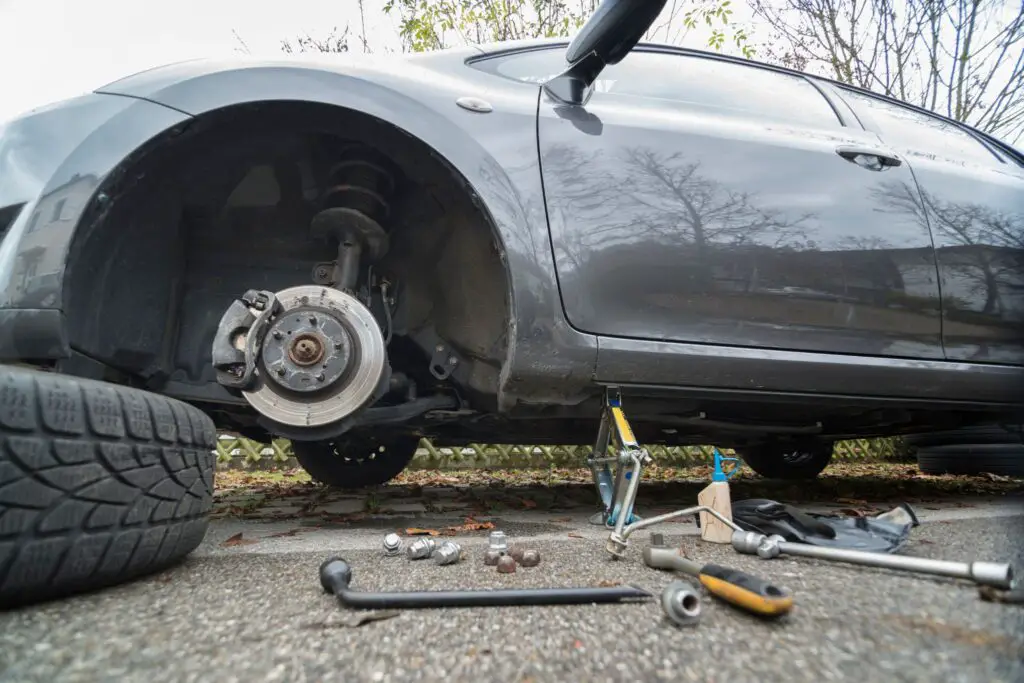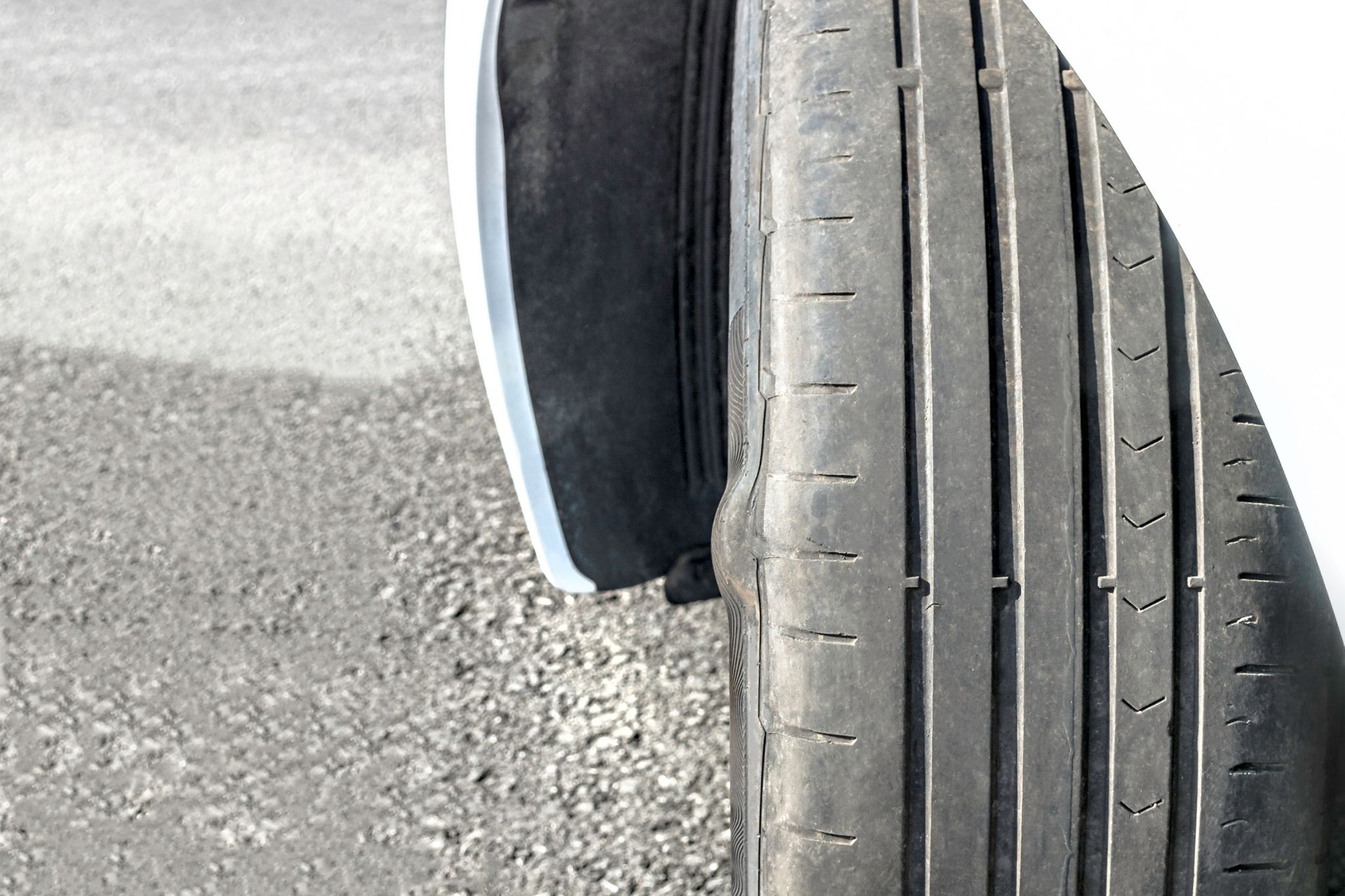Tires are regularly exposed to very severe stress and pressures, such that one needs to keep checking up on them, just in case constantly.
They commonly developed faults in the event of hitting an obstacle on the road, such as pot-holes. They get damaged also due to tire separation from the rim or sidewall ripples too.
Sometimes, a weakened focus may appear as a sort of knot or bubble on the side of the tire or its sidewall. What happens when you see this bulge or bubble? Can you still drive the tire like that? How long can you drive with a bulge in your tire? or rather, How long can you drive with a bubble in your tire?
Let’s find out!
How Long Can I drive with A Knot In My Tire? You can drive for zero miles on a tire with a knot. This implies that, under no circumstance, should you drive with a bulge or knot in your tire. Doing this is potentially very dangerous.
In fact, you are not recommended to drive for even the shortest distance possible on bulging tires, not even to where you will get them replaced. In extreme circumstances, you may drive with it onto the back of a tow truck. Though, even that is not advised at all.
How Long can i Drive With a Bulge in My Tire


A tire bulge or tire bubble is basically the same as a tire knot. These are formed as a result of a weakened tire sidewall – an indication that the internal structure of your tires has been compromised.
It’s important to have this checked out as soon as possible by an expert to prevent any sort of further damage to your tires and or your vehicle.
But, how long exactly can you drive your car with a bulged tire? Well, It’s not recommended to drive with a bulge in your tires – it can lead to serious safety hazards and should be avoided completely.
The driving distance should be zero miles – meaning you should have your tire checked and replaced before proceeding with the rest of your journey.
Can I drive with a knot in my tire?
You must not drive with a knot in your tire. In fact, the seriousness of the issue is such that you are not advised to drive on a knotted tire to even the nearest mechanic. A tire with a knot in it is a disaster waiting to happen.
This is usually because such a tire has its structural integrity compromised, due to which it can blow out at any time. So, desist from running on knotted tires, no matter how small the knot may be.
Is it safe to drive on a tire with a knot?
No, it is not. Not safe in the least. Any tire with a knot in it is simply a sitting bomb waiting to detonate.
This is particularly so knowing that such a tire can blow out any second, with severe or even fatal consequences to you and other road users as well, not to mention potential damage to the vehicle also.
How far can you drive with a knot in your tire?
You can drive for as long as zero miles with a bubble or knot in your tire. To drive a car with a knot or bubble in its tire is simply to invite trouble. For one, a tire with a knot in it can blow up at any time with possibly very serious consequences. (Read Also: Will LandCruiser Wheel Fit Hilux?)
For this reason, you are not at all advised to drive it for any distance even to the nearest place where you can get it fixed.
As a result, the moment you are lucky to notice such a knot, park it at a safe place away from other vehicles and make arrangements for the replacement of the affected tire immediately.
In the alternative, if you have a truck at hand that can carry it, you may at least drive it onto the bed of the truck. That is the longest permissible distance you can drive it.
How long will a tire with a knot last?
It does not matter at all how long a tire with a knot lasts or how good-looking it may appear to any visual inspection.
So long as the tire has a knot in it, such a tire is summarily useless, for your sake and that of all other road users.
So, as far as you are concerned, a knotted tire has lasted its entire lifespan as a tire. It is no longer of any motorable importance, or it doesn’t exist.
How can I remove a knot in my tire?
There is absolutely no need to attempt the removal of a knot in a tire. Whenever any tire develops a knot in it, the structural integrity and safe use of the tire are totally compromised.
That the tire has lost its structural integrity simply implies that it cannot be trusted to function safely anymore. Despite the risks in doing this, some people are known to make attempts at using either thin metallic wires or strengthened threads to sew up the site of the bulge or knot.
This is against all traffic regulations which can even cause you a fine for a traffic violation in some places. Therefore, the moment you notice any tire knot, your main focus should be on how to get the tire replaced and nothing else.
(Read Also: Can Tire Shine Damage Paint?)
How do you fix a tire knot?
A tire knot is just not fixable. Fixing it no matter how crafty done is at best a risky enterprise. Therefore, never resort to any tire repairs in such instances. It is more so where the tire knot is in the sidewall of the tire since the sidewall is the most vulnerable part of any tire.
To worsen matters, the tire sidewall does not have any metallic wire embedded in it, which makes a knot in the sidewall a most serious issue, and one that we should not treat with any levity. So, never attempt to undertake the repairs of any tire with a knot in it, for your safety as much as for others too.
Can you fix a bubble in a tire?
You are strictly advised not to undertake any such fixing in your own interest. The instant you notice any bubble, bulge, or knot in your tire, the only option is an immediate replacement and nothing else.
Any tire with a bubble cannot be trusted in any way, because its ability to bear the weight of the vehicle as well as any cargo on it, is simply not a guarantee at that stage. So, refrain from any such repairs forthwith.
Trending Searches
- How Long Can A Car Sit On A Flat Tire?
- How Long Does A Nail Have To Be To Puncture A Tire?
- How To Prove Someone Slashed Your Tires
Can you put air in a tire with a bubble?


Yes, you can, but it is just not advisable to do so. Any tire of that nature is fundamentally weak, and as such lacks the strength to withstand the pressure that will be exerted by air inflation. First, it is most likely going to blow up upon any pressure due to air inflation.
Again, even if you are able to manage and inflate it, the tire can go off at any time thereby putting you and also the vehicle at serious risk of possible accidents. As a result, never endeavor to put any air in a tire with a visible bubble in it, regardless of where the bubble is sited on it. It is an unsafe venture, at best.
What are the warning signs of tire trouble?
There are many signs a compromised tire is bound to show before it finally packs up. First, it is most likely for any bad tire to start deflating of its own volition overnight after you have parked it for the day.
If it does not do this, it may become necessary for you to reinflate it regularly because it keeps losing air while being driven. Another common sign of tire trouble is the visible balding of its treads.
When you notice this balding state, the tire is pretty old and worn out, which means that it can no longer be trusted anymore.
Sometimes, you may notice that your tire is rubbing against something in the tire well where it sits. If care is not taken by removing the cause of this rubbing, the tire may soon be out of use.
At other times, the tire may be new and still possess very prominent treads. Despite this, it may still be losing air suspiciously.
At any time that you have to top up on tire air regularly, even when the tire has no identifiable hole in it, the chances are that the valve of the tire may be faulty or the valve cap is lost. A bad tire may also present as a wobble during motion.
When this happens, the tire might have worn out very severely at some place on its surface. Promptly make sure that the experts inspect it for the necessary attention.
Sometimes, if you listen carefully, you may get to hear the hissing sound of air escaping from the tire due to a faulty tire valve.
If you are not able to hear any hissing sound of escaping air from the tire, you can alternatively use soapy water on the mouth of the tire valve.
When you do this, provided the valve is faulty, you will notice that the soapy water will give off bubbles, which indicates that the escaping air is blowing the soapy water into bubbles.
Finally, worn-out or very bald tires can increase your braking distance. This means that your brakes are not very effective, because they no longer function as effectively as they have been doing previously or how they should be doing.
Very bald tires have this effect on your braking efficiency. As a matter of fact, there are many other signs of a bad tire. Another very important sign of tire trouble is the presence of cracks or cuts, particularly in its sidewall, or persistent vibration of the car as you drive along.
All in all, if you wish to reliably diagnose tire tread wear, you can use the Lincoln head penny as a tire tread wear indicator.
This will tell you whether the tire treads are worn out or not, regardless of what you might have observed ordinarily since sometimes, the sight can be deceptive. The signs given here are sufficient for you to diagnose the most common tire complaints without any expert help.
Will a knot damage your tire?
Of course, it can. In fact, nothing damages a tire beyond any use more than a knot in it. A knot in a tire is simply telling you that such a tire can no longer be trusted to serve in any capacity.
First, it may eventually blow up if you attempt to inflate it or even when just driving on the road, with severe repercussions. A knot in a tire is a point of weakness through which the tire will most easily blow out if not replaced immediately.
What are the causes of tire bubbles?
Tire bubbles are mostly caused by the leaking of air from inside the tire and into the carcass or body of the tire. However, bubbles in the tire sidewalls are commonly caused by sudden forceful impacts and damage or any persistent rubbing of the tire against something in the tire well.
After hitting an object, as may be occasioned in an accident, the weight and speed of the vehicle is primarily directed in any small area of contact, which may eventually become a bubble in the tire.
Can tire bubbles be replaced?
There is no point in replacing any tire bubble. The moment a tire shows any knot, bubble, or bulge, make every possible effort to simply replace it entirely and nothing else, in your own interest.
Tire bubbles are known to occur in the tire’s inner lining, which is the cause of containing the air, weakening and springing a focus for air leakage out of it. It is known that air, due to the pressure from the road, seeps via this tire lining and is trapped just beneath the outer layer of the tire.
How much does it cost to fix a tire bubble?
There is nothing like paying to fix a tire bubble at all. Any tire with a bubble cannot, and must not be repaired, but rather replaced immediately. In that case, let us talk about the cost of tire replacement, which is the only available option.


A new tire costs between 150 and 600 dollars, depending on the size and type of the tire.
How Long Can I drive with A Knot In My Tire – Conclusion
To every driver, the primary and most important goal should be safety and nothing else. It is for this reason that anything which has the tendency to put lives at risk is not treated with any levity.
Therefore, refrain from repairing any tire defects that are not just repairable, in your own interest. After all, you should be driving to stay alive and not otherwise. So, if you must replace any tire in order to stay alive and safe, by all means, do just that.
This post contains affiliate links. Read the full disclosure here.


I am passionate about all things automotive and have a deep understanding of the topic. As a mechanic, I use my free time to share knowledge of everyday challenges that any car owner can experience – helping you make informed decisions about tires.

